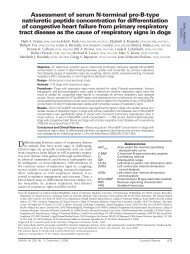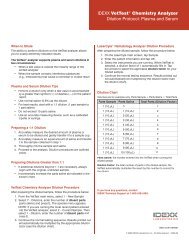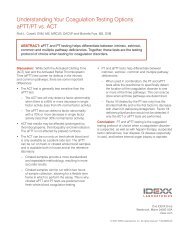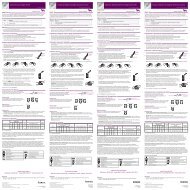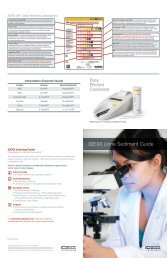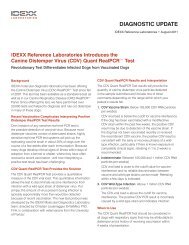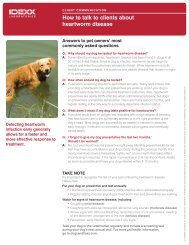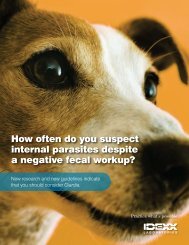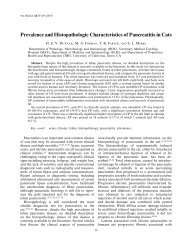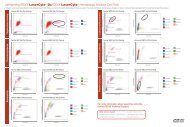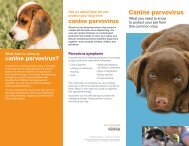Cardiopet proBNP Brochure
Cardiopet proBNP Brochure
Cardiopet proBNP Brochure
- No tags were found...
You also want an ePaper? Increase the reach of your titles
YUMPU automatically turns print PDFs into web optimized ePapers that Google loves.
<strong>Cardiopet</strong> ® <strong>proBNP</strong>
Heart diseases in dogs and catsThe risk of heart disease in dogs increases dramatically with age. Up to 15 % of dogs have heartdisease, and this rate increases to over 60 % in aged dogs. 1, 2Diagnosing cardiac disease in cats can be especially difficult. Cats present with few, if any, clinicalsigns and thoracic auscultation is normal in 30 % of cats with heart disease. 3The three most commonlydiagnosed cardiac diseasesMitral valve disease A leaky valve andeventually a dilated or stretched leftventricle affect the ability of the heart topump efficiently.Dilated cardiomyopathy The musclesof the heart become weak and dilated,causing the heart to pump inefficiently.BloodbackflowthroughvalveEnlargedsphericalchambersThin/weakventriclewallsHypertrophic cardiomyopathy (cats) Theheart muscle becomes thickened, limitingblood flow from the left atria to the ventricle.ThickventriclewallsRegardless of the underlying cause that triggersheart disease, the patient ultimately cascadesinto a downward spiral leading to congestiveheart failure. Early detection and therapy maybreak the cycle and improve outcomes.Cardiac outputfalls furtherCardiac output decreasesArterial Blood pressure fallsHeart DiseaseProgressesCongestive heartfailure developsHow <strong>Cardiopet</strong> ® <strong>proBNP</strong> worksAs the chambers of the heart are stretched, they releaseBNP. First discovered in 1988 and routinely used as acardiac marker in humans, BNP is a peptide stored as a“pro-hormone.” As heart disease progresses, the chambersbecome more stretched and BNP is released in greaterquantities. <strong>Cardiopet</strong> ® <strong>proBNP</strong> measures Nt-<strong>proBNP</strong>, allowingyou to quantitatively track the progression of the disease andmake judgments about the condition of the heart.ProhormoneHeart DiseaseCompensatory mechanisms activateHeart DiseaseCleavagesiteVasoconstrictionFluid retentionIncreased volumestimulates theheart to pumpHeart muscle cellBNPIncreasedvascularresistanceBloodvolumeincreasesBloodNt-<strong>proBNP</strong>nordic233-06101 Edmonton MH. School of Veterinary Medicine Offers Cardiology Services. LSU Today. 2002;18(40).2 Rush JE. Chronic Valvular Heart Disease in Dogs. Proceedings from: 26th Annual Waltham Diets/OSU Symposium for the Treatment of Small Animal Cardiology; October 19–20, 2002.3 Cats with confirmed hypertrophic cardiomyopathy as part of a clinical study conducted at the University of Illinois;1998 –1999.<strong>Cardiopet</strong> ® <strong>proBNP</strong>
<strong>Cardiopet</strong> ® <strong>proBNP</strong> and the DogClinical Guidance and Interpretative CriteriaThe <strong>Cardiopet</strong> ® <strong>proBNP</strong> test measures Nt-<strong>proBNP</strong>, which is released from the heartmuscle in proportion to the severity of heart stretch/stress. Use this test for murmur dogswith mild to more severe clinical signs, such as coughing, dyspnoea or tachypnoeato determine if those signs are cardiac in origin.• Murmur and clinical signs, e.g.:· Cough, dyspnoea, cyanosis(to differentiate respiratorydisease from heart disease)· Exercise intolerance, lethargy• Breeds predisposed to heart disease and showinga murmur as well as clinical signsClinical examinationwith auscultationBlood work including<strong>Cardiopet</strong> ® <strong>proBNP</strong>Chest radiographs+/– ECGExpanded cardiac workup includes echocardiogram, chest radiograph, ECGInterpretative Criteria1800 pmol/l The likelihood that clinical signs (e.g. respiratoryand/or exercise intolerance) are due to heart failureis high. Further cardiac workup or cardiac consultationrecommended.Therapeutic decisions should be based on results of a cardiac workup.Nt-<strong>proBNP</strong> concentrations may decrease with cardiac medication. Arrhythmias and the presenceof pulmonary hypertension may result in higher Nt-<strong>proBNP</strong> concentrations. Azotaemic dogs mayhave increased Nt-<strong>proBNP</strong> concentrations.nordic233-0610<strong>Cardiopet</strong> ® <strong>proBNP</strong>
<strong>Cardiopet</strong> ® <strong>proBNP</strong> and the CatClinical Guidance and Interpretative CriteriaStudies 1 show that 1 in 6 cats can have hypertrophic cardiomyopathy, yetthese patients may show no signs at all. The <strong>Cardiopet</strong> ® <strong>proBNP</strong> testcan be used to screen all cats to assure early detection.• Screen all cats(symptomatic or non-symptomatic), e.g.:· Preanaesthetic work-up· As part of a wellness screen· All breeds predisposed to heart disease• In case of clinical symptoms, e.g.:· Murmur, gallop, arrhythmia· Cough, dyspnoea, cyanosis· Exercise intolerance, lethargy· Hind limb paresis/paralysisPhysical examinationwith auscultationBlood work including<strong>Cardiopet</strong> ® <strong>proBNP</strong>(Chest radiographs) 2+/– ECGExpanded cardiac workup includes echocardiogram, chest radiograph, ECGInterpretative Criteria270 pmol/l Clinically significant cardiomyopathy is highly likely.Further cardiac workup including an echocardiogramis recommended.Therapeutic decisions should be based on results of a cardiac workup.Nt-<strong>proBNP</strong> concentrations may decrease with cardiac medication. Arrhythmias may result inhigher Nt-<strong>proBNP</strong> concentrations. Cats with severe respiratory disease can have increasedNt-<strong>proBNP</strong> due to pulmonary hypertension which creates myocardial stress. Severelyazotaemic cats may have increased Nt-<strong>proBNP</strong> concentrations.1 Paige CF, Abbott JA, Elvinger F, Pyle RL. Prevalence of cardiomyopathy in apparently healthy cats. JAVMA. 2009;234(11):1398–1403.2 Only recommended in case of clinical symptomsnordic233-0610<strong>Cardiopet</strong> ® <strong>proBNP</strong>



